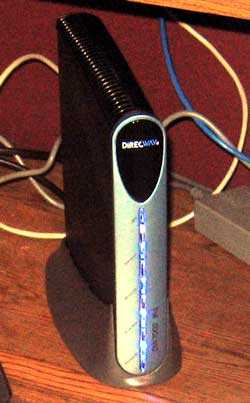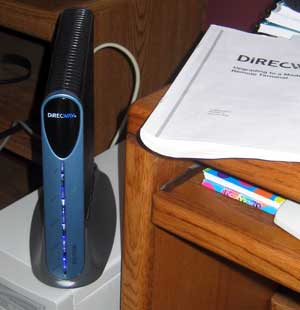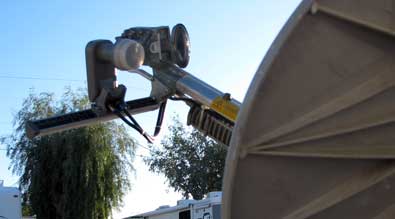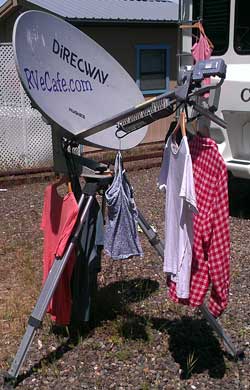Installation of Satellite
Internet .. part 3

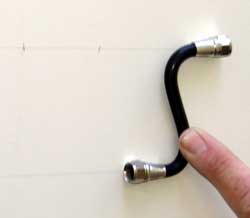
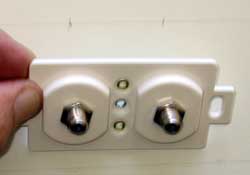
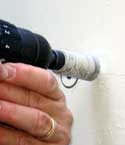
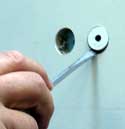

The holes are drilled, plugs removed then the foam is removed to create a passage from the exterior to interior holes. |
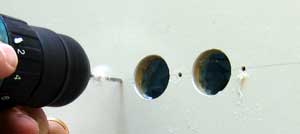 |
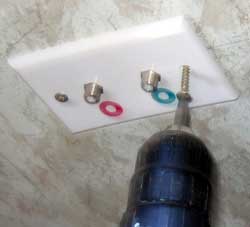 |
Pilot holes are drilled in the exterior and interior walls for the fixture mounting screws. You can clearly see the blue and red markings for the cables. Red for transmit and blue for the receive cables. |
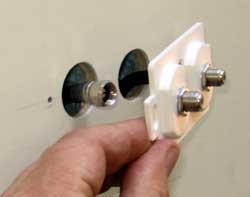
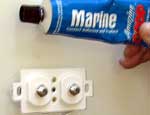
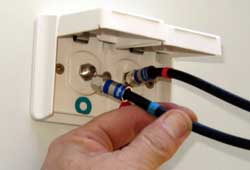
 |
The final project is professionally completed by connecting the DW6000 modem to the transmit and receive cables then using Cat5 cable to connect to the Linksys WRT54G wireless router. The router |
Also, I'm not sure I ever reported on the ease of taking down and setting up the system. During our Oregon Coast trip I got plenty of practice. Take down is about 10 minutes and setup averaged about 15 minutes depending upon weather conditions and figuring where to set the tripod to avoid obstructions such as trees. The OPI meter was virtually worthless. I fooled with it for 3 hours my first time before calling Glenn. He reported that it can't be trusted and others were also having problems. I stopped using it and used Gwen's laptop computer instead to identify signal strength. I could do this at the tripod because we have a wireless router network. If you don't have a wireless network, you must use the "screamer" method where your partner yells out the window the signal strength. This method worked perfectly and quickly for us so we never tried the OPI meter again. If someone tells you it is manditory or that a "bird-dog meter" is needed, they are just looking for more profit..
| It was a lot more work than I figured removing and replacing the 3mm bolts connecting the transmitter to the fog horn. Once completed | 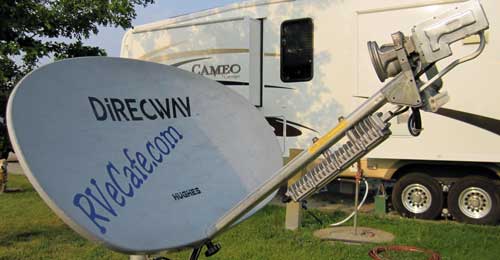 |
| it was a matter of reconnecting the coax cables. The system is NOT working so I'm hoping the new power supply will make the repair. I should have it on Monday. Just for your information, I no longer recommend satellite Internet for RV travel or for ANY use unless you have NO other option. We pay $70/month for this system which SHOULD operate at 1 meg download and 200K upload. It's rarely that fast, especially recently. My friends Ralph and Janet have a Verizon 3G modem/router so up to 5 computers can login at one time. I would estimate their speed at 5 times HughesNet and they pay only $40/month. The downside? Ralph and Janet traveled with us through Arizona, New Mexico, Texas, Louisiana, Mississippi, Tennessee and Kentucky. Their Verizon system was usable about 80% of the time since they must be in range of a cell tower. To be honest, our campsites in the southern states often had such a heavy tree canopy, we could not get satellite reception. In fact, we would login to their network when we couldn't get connected (due to the heavy canopy) and they would login to our network when they were out of range of a cell tower. So if you must absolutely must have Internet access each day, you need BOTH systems. Satellite Internet is still better than "dial up" access. So a situation where you MUST have satellite Internet would be where you are often camped out of range of a cell tower or permanently living in a rural area beyond 3G range. If that's not the case, go with 3G or 4G access, compared to satellite it's far easier plus much faster and cheaper. | |
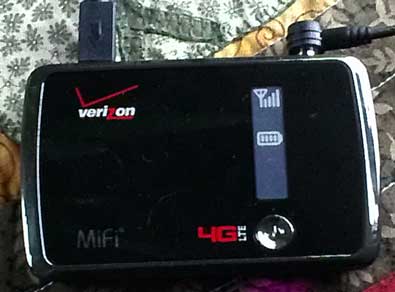 and Costco is reimbursing us for the $35 activation fee. We had to enroll in a 2 year program. We are paying for the 5 gig/month plan ($50) which means we are limited to 5 gig of transfer (both upload and download) per month before penalties apply. Connecting at 3G speeds, we should get about 1.5 meg download and 500K upload speeds. Verizon brags that with 4g we might get as much as 12meg download speeds. We've had the unit a week and have not been in a 4G area so can't say. In the photo you see a tiny antenna with 4 bars next to it indicating a strong signal. That's because an external antenna is plugged into the unit, without the external antenna, we get only ONE bar and very unreliable Internet speeds. You don't need an external antenna but where we are currently parked, it makes a huge difference. You can click the photo to see the antenna next to my Davis weather station. Using the MiFi for a week, I am surprised at how much transfer we have logged. We have nearly a full gig of transfer, which means 4 gigs in a month at our current rate. We are limited to 5 gigs without penalty so we must be careful about watching videos, downloading files (such as music downloads) and anything else that might be large transfers. We will know more as we've used MiFi longer. As for speed, the MiFi is noticeably faster than HughesNet as long as I'm using the external antenna.
and Costco is reimbursing us for the $35 activation fee. We had to enroll in a 2 year program. We are paying for the 5 gig/month plan ($50) which means we are limited to 5 gig of transfer (both upload and download) per month before penalties apply. Connecting at 3G speeds, we should get about 1.5 meg download and 500K upload speeds. Verizon brags that with 4g we might get as much as 12meg download speeds. We've had the unit a week and have not been in a 4G area so can't say. In the photo you see a tiny antenna with 4 bars next to it indicating a strong signal. That's because an external antenna is plugged into the unit, without the external antenna, we get only ONE bar and very unreliable Internet speeds. You don't need an external antenna but where we are currently parked, it makes a huge difference. You can click the photo to see the antenna next to my Davis weather station. Using the MiFi for a week, I am surprised at how much transfer we have logged. We have nearly a full gig of transfer, which means 4 gigs in a month at our current rate. We are limited to 5 gigs without penalty so we must be careful about watching videos, downloading files (such as music downloads) and anything else that might be large transfers. We will know more as we've used MiFi longer. As for speed, the MiFi is noticeably faster than HughesNet as long as I'm using the external antenna.Saturday, June 2, 2012: Here is a use Gwen discovered for the HughesNet satellite dish. I can't get rid of it yet because I have a couple of months to go on the DirecTV contract and this is the dish I use to get DirecTV. Once that contract is fulfilled, then I should leave this dish somewhere. Right, we don't plan to continue the DirecTV contract either. It's just too expensive for the few times each year that we get the sports shows we like (such as the French Open Tennis match which is happening this last week and for another week). It's just crazy paying $85/month for TV with NO premium channels.
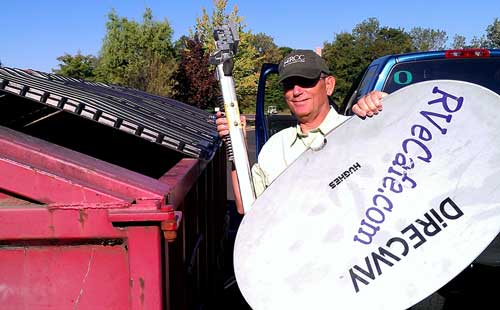 transmitter since it was about a year old but the last time I tried to connect with HughesNet, transmit would not work. It may not have been the transmitter which caused the problem but I have no way to know the cause of the problem since I no longer have a HughesNet account. The last year of using HughesNet has been very unreliable. When I purchased this system, I expected to use it for 2 years before something better and cheaper came along. Instead, I used it for six years. Now, the only reason I can see using satellite Internet is if there is no other choice. You are traveling into remote areas where satellite is the only option would be a reason to choose HughesNet. Otherwise, Verizon MiFi is faster and cheaper than HughesNet.
transmitter since it was about a year old but the last time I tried to connect with HughesNet, transmit would not work. It may not have been the transmitter which caused the problem but I have no way to know the cause of the problem since I no longer have a HughesNet account. The last year of using HughesNet has been very unreliable. When I purchased this system, I expected to use it for 2 years before something better and cheaper came along. Instead, I used it for six years. Now, the only reason I can see using satellite Internet is if there is no other choice. You are traveling into remote areas where satellite is the only option would be a reason to choose HughesNet. Otherwise, Verizon MiFi is faster and cheaper than HughesNet. 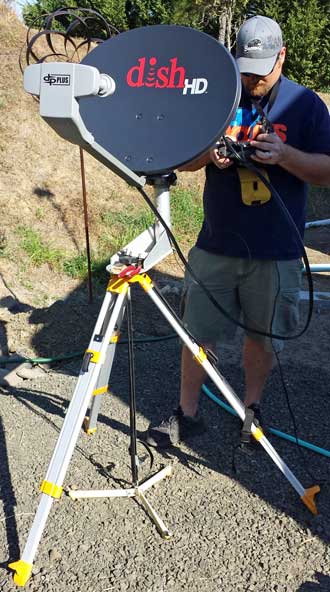 Sunday, September 7, 2014: I swore I was never going to have satellite TV ever again but I've had to retract my statement. The park will discontinue the Charter TV contract when it expires in a few months so we must come up with our own TV provider. We chose DISH Network because it is easier to point and we plan to move the service with us when we travel. Do you recognize some of the equipment in this photo? I gave away my "surveyor tripod" several months ago since I hadn't used it in 2 years so had to replace the tripod. I still had the "Claw" which anchors the tripod and the hardware for dish mounting and pointing. This system came with the "Hopper", the DISH version of a DVR (digital video recorder) with many new features from the last time we had a DVR several years ago. Many of the new features require Internet access which we will lose when we travel.
Sunday, September 7, 2014: I swore I was never going to have satellite TV ever again but I've had to retract my statement. The park will discontinue the Charter TV contract when it expires in a few months so we must come up with our own TV provider. We chose DISH Network because it is easier to point and we plan to move the service with us when we travel. Do you recognize some of the equipment in this photo? I gave away my "surveyor tripod" several months ago since I hadn't used it in 2 years so had to replace the tripod. I still had the "Claw" which anchors the tripod and the hardware for dish mounting and pointing. This system came with the "Hopper", the DISH version of a DVR (digital video recorder) with many new features from the last time we had a DVR several years ago. Many of the new features require Internet access which we will lose when we travel. | Return to Part 1 |
